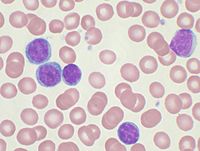
Pembrolizumab Added to Ifosfamide, Carboplatin, and Etoposide Chemotherapy for Relapsed or Refractory Classic Hodgkin Lymphoma: A Multi-institutional Phase 2 Investigator-Initiated Nonrandomized Clinical Trial.
Sign Up to like & getrecommendations! Published in 2023 at "JAMA oncology"
DOI: 10.1001/jamaoncol.2022.7975
Abstract: Importance To our knowledge, this is the first clinical trial designed to investigate concurrent treatment with a checkpoint inhibitor and conventional chemotherapy in relapsed or refractory classic Hodgkin lymphoma in patients destined for an autologous… read more here.
Keywords: hodgkin lymphoma; relapsed refractory; refractory classic; chemotherapy ... See more keywords

Long‐term risk of cardiovascular disease mortality among classic Hodgkin lymphoma survivors
Sign Up to like & getrecommendations! Published in 2022 at "Cancer"
DOI: 10.1002/cncr.34375
Abstract: The temporal trend of cardiovascular disease (CVD) mortality in patients with classic Hodgkin lymphoma (cHL) throughout follow‐up remains unclear. This study aimed to assess this temporal trend in patients with cHL. read more here.
Keywords: cardiovascular disease; mortality; hodgkin lymphoma; classic hodgkin ... See more keywords

Flow cytometry assessment of reactive T‐cells distinguishes classic Hodgkin lymphoma from benign lymphadenopathy in children
Sign Up to like & getrecommendations! Published in 2022 at "Journal of Clinical Laboratory Analysis"
DOI: 10.1002/jcla.24661
Abstract: Detection of classic Hodgkin lymphoma (cHL) neoplastic cells using flow cytometric immunophenotyping (FCI) remains limited. We hypothesized that characterization of the reactive infiltrates could assist in diagnosing cHL in children. read more here.
Keywords: hodgkin lymphoma; flow cytometry; assessment reactive; classic hodgkin ... See more keywords

The value of thymus and activation related chemokine immunohistochemistry in classic Hodgkin lymphoma diagnostics
Sign Up to like & getrecommendations! Published in 2022 at "Histopathology"
DOI: 10.1111/his.14836
Abstract: Classic Hodgkin lymphoma (cHL) should be distinguished from its wide variety of histological mimics, including reactive conditions and mature B and T cell neoplasms. Thymus and activation‐related chemokine (TARC) is produced in extremely high quantities… read more here.
Keywords: hodgkin lymphoma; activation related; related chemokine; thymus activation ... See more keywords

Dissecting Clonal Hematopoiesis in Tissues of Patients with Classic Hodgkin Lymphoma.
Sign Up to like & getrecommendations! Published in 2021 at "Cancer discovery"
DOI: 10.1158/2643-3230.bcd-20-0203
Abstract: Clonal hematopoiesis predisposes to hematologic malignancies. However, clonal hematopoiesis is understudied in classic Hodgkin lymphoma (cHL), a mature B-cell neoplasm exhibiting the most abundant microenvironment. We analyzed clonal hematopoiesis in 40 cHL cases by sequencing… read more here.
Keywords: blood; hematopoiesis; hodgkin lymphoma; clonal hematopoiesis ... See more keywords

Positron Emission Tomography–Adapted Therapy in Bulky Stage I/II Classic Hodgkin Lymphoma: CALGB 50801 (Alliance)
Sign Up to like & getrecommendations! Published in 2022 at "Journal of Clinical Oncology"
DOI: 10.1200/jco.22.00947
Abstract: PURPOSE Patients with bulky stage I/II classic Hodgkin lymphoma (cHL) are typically treated with chemotherapy followed by radiation. Late effects associated with radiotherapy include increased risk of second cancer and cardiovascular disease. We tested a… read more here.
Keywords: bulky stage; hodgkin lymphoma; stage classic; pet2 ... See more keywords

Assessment of the Neutrophil-Lymphocyte Ratio in Classic Hodgkin Lymphoma Patients
Sign Up to like & getrecommendations! Published in 2019 at "Pakistan Journal of Medical Sciences"
DOI: 10.12669/pjms.35.5.601
Abstract: Background and Objective: Besides known risk scoring systems, studies have recently been conducted in relation to NLR to estimate the prognosis of HL. Some studies found a relationship of NLR with PFS and OS. Our… read more here.
Keywords: risk; hodgkin lymphoma; time diagnosis; classic hodgkin ... See more keywords

Killer Cell Immunoglobulin-Like Receptor Haplotype B Modulates Susceptibility to EBV-Associated Classic Hodgkin Lymphoma
Sign Up to like & getrecommendations! Published in 2022 at "Frontiers in Immunology"
DOI: 10.3389/fimmu.2022.829943
Abstract: Tumor cells of classic Hodgkin lymphoma (cHL) are derived from antigen presenting B cells that are infected by Epstein Barr virus (EBV) in ~30% of patients. Polymorphic Killer cell immunoglobulin-like receptors (KIRs) expressed on NK… read more here.
Keywords: classic hodgkin; hodgkin lymphoma; killer cell; cell immunoglobulin ... See more keywords

Macrophage Infiltration Correlates with Genomic Instability in Classic Hodgkin Lymphoma
Sign Up to like & getrecommendations! Published in 2022 at "Biomedicines"
DOI: 10.3390/biomedicines10030579
Abstract: Hodgkin lymphoma (HL) is a biologically diverse group of lymphoid tumors, which accounts for 1% of all de novo neoplasms in the world’s population. It is divided into two main groups: the more common classic… read more here.
Keywords: chl; hodgkin lymphoma; lymphoma; tumor cells ... See more keywords

Immunosuppressive Microenvironment and Efficacy of PD-1 Inhibitors in Relapsed/Refractory Classic Hodgkin Lymphoma: Checkpoint Molecules Landscape and Macrophage Populations
Sign Up to like & getrecommendations! Published in 2021 at "Cancers"
DOI: 10.3390/cancers13225676
Abstract: Simple Summary Classic Hodgkin lymphoma contains rare malignant Hodgkin/Reed–Sternberg cells and abundant reactive populations in the tumor microenvironment. Many aspects of the interaction between tumor cells and immune cells remain unclear. Nevertheless, the microenvironment is… read more here.
Keywords: relapsed refractory; microenvironment; hodgkin lymphoma; hodgkin ... See more keywords

The Need for Standardization in Next-Generation Sequencing Studies for Classic Hodgkin Lymphoma: A Systematic Review
Sign Up to like & getrecommendations! Published in 2022 at "Diagnostics"
DOI: 10.3390/diagnostics12040963
Abstract: Classic Hodgkin lymphoma (cHL) constitutes a B cell-derived neoplasm defined by a scarce tumoral population, termed Hodgkin and Reed–Sternberg (HRS) cells, submerged into a histologically heterogeneous microenvironment. The paucity of HRS cells has historically hampered… read more here.
Keywords: need standardization; hodgkin lymphoma; systematic review; next generation ... See more keywords